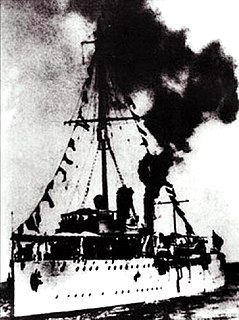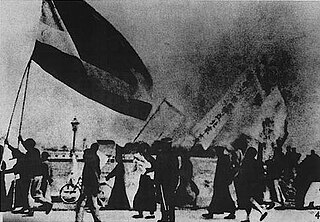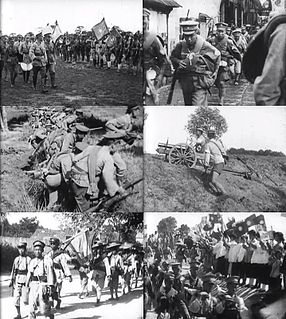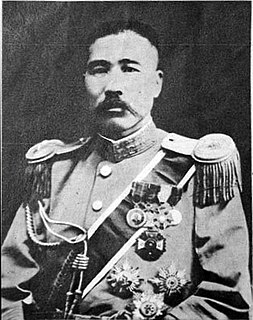 W
WThe Warlord Era was a period in the history of the Republic of China when control of the country was divided among former military cliques of the Beiyang Army and other regional factions from 1916 to 1928.
 W
WThe Warlord Era was a historical period of the Republic of China that began from 1916 and lasted until the mid-1930s, during which the country was divided and ruled by various military cliques following the death of Yuan Shikai in 1916. Communist revolution broke out in the later part of the warlord period, beginning the Chinese Civil War. The era nominally ended in 1928 at the conclusion of the Northern Expedition with the Northeast Flag Replacement, beginning the "Nanjing decade". However, "residual warlords" continued to exist into the 1930s under de jure Kuomintang rule, and remained until the end of the Communist victory in 1949.
 W
WThe Spirit Soldier rebellions of 1920–1926 were a series of major peasant uprisings against state authorities and warlords in the Republic of China's provinces of Hubei and Sichuan during the Warlord Era. Following years of brutal suppression, civil war, and excessive taxation, the rural population of central China was restive, and susceptible to militant salvationist movements. One spiritual group, the so-called Spirit Soldiers, promised the peasants that they could gain protection from modern weaponry through protective magic. Tens of thousands consequently rallied to join the Spirit Soldiers, and successfully revolted in the mountainous and isolated areas of Hubei and Sichuan. At its height, the Spirit Soldier movement numbered over 100,000 fighters, and controlled about forty counties.
 W
WBabojab was an ethnic Mongol prince and military leader. The Japanese planned to overthrow Yuan Shih-k'ai's government by supporting Babojab in his effort to re-establish the Qing dynasty, which would rule Mongolia, Manchuria, and North China. At the end of 1915, Babojab's army retreated to Hailar after attacks from Khatanbaatar Magsarjav near Dolon Nor and Kuke Khoto. His troops fought Chinese soldiers in Manchuria and Inner Mongolia during the Warlord Era. In July 1916 following the death of Yuan Shikai, he enlisted the help of Kawashima Naniwa and other Japanese nationals and raised an army. Three thousand Mongolian cavalrymen defeated Wu Junsheng's Fengtian Clique and occupied Guojiadian in Shandong, on the main line of the South Manchuria Railway. However, later that year Babojab was killed and his army defeated near Linxi, Inner Mongolia.
 W
WThe Beiyang Army, named after the Beiyang region, was a powerful, Western-style Imperial Chinese Army established by the Qing Dynasty government in the late 19th century. It was the centerpiece of a general reconstruction of Qing China's military system. The Beiyang Army played a major role in Chinese politics for at least three decades and arguably right up to 1949. It made the Xinhai Revolution of 1911 possible, and, by dividing into warlord factions known as the Beiyang Clique, ushered in a period of regional division.
 W
WThe Beiyang government, officially the Republic of China, also sometimes spelled Peiyang Government or the First Republic of China, refers to the government of the Republic of China which sat in its capital Peking (Beijing) between 1912 and 1928. It was internationally recognized as the legitimate Chinese government during that time.
 W
WThe Canton Coup of 20 March 1926, also known as the Zhongshan Incident or the March 20th Incident, was a purge of Communist elements of the Nationalist army in Guangzhou undertaken by Chiang Kai-shek. The incident solidified Chiang's power immediately before the successful Northern Expedition, turning him into the paramount leader of the country.
 W
WThe Central Plains War was a series of military campaigns in 1929 and 1930 that constituted a Chinese civil war between the Nationalist Kuomintang government in Nanjing led by Generalissimo Chiang Kai-shek and several regional military commanders and warlords that were former allies of Chiang.
 W
WThe Chiang-Gui War was a military conflict between the Nationalist government of Chiang Kai-shek against the warlord army of Guangxi that lasted from March until June 1929. A later conflict, the 2nd Chiang Gui-War, occurred between the two opposing factions in November and December of the same year.
 W
WThe Empire of China was a short-lived attempt by statesman, general and president Yuan Shikai from late 1915 to early 1916 to reinstate monarchy in China, with himself as the Hongxian Emperor. The attempt was unsuccessful; it set back the Chinese republican cause by many years and fractured China into a period of conflict between various local warlords.
 W
WThe Fengtian clique was one of several opposing military factions that constituted the early Republic of China during its Warlord Era. It was named after Fengtian Province, and operated from a territorial base comprising the three northeastern provinces that made up Manchuria. Warlord Zhang Zuolin, known as the "Old Marshal," led the clique with support from Japan.
 W
WThe Han–Liu War was a major military conflict in late 1932 between the private armies of Han Fuju and Liu Zhennian over Shandong. Even though Han as well as Liu were officially subordinates to the Chinese Nationalist government in Nanjing, both were effectively warlords with their own autonomous territories. Han Fuju controlled most of Shandong and had long desired to also capture the eastern part of the province, which was held by Liu. The tensions between the two eventually escalated, leading to a war that saw Han emerge victorious. He went on to rule Shandong unopposed for the next six years, while Liu was exiled to southern China.
 W
WThe Huanggutun Incident, also known as the Zhang Zuolin Explosion Death Incident , was the assassination of the Fengtian warlord Zhang Zuolin near Shenyang on 4 June 1928.
 W
WThe Looting of the Eastern Mausoleum was an incident in which some of the major mausoleums of the Chinese Qing dynasty in the Eastern Qing Tombs were looted by troops under the command of the warlord Sun Dianying.
 W
WThe May Fourth Movement was a Chinese anti-imperialist, cultural, and political movement which grew out of student protests in Beijing on 4 May 1919.
 W
WThe National Pacification Army (NPA), also known as the Anguojun or Ankuochun, was a warlord coalition led by Fengtian clique General Zhang Zuolin, and was the military arm of the Beiyang government of the Republic of China.
 W
WThe National Protection War, also known as the Anti-Monarchy War, was a civil war that took place in China between 1915 and 1916. Only three years earlier, the last orthodox Chinese dynasty, the Qing dynasty, had been overthrown and the Republic of China was established in its place. The cause of the war was the proclamation by Yuan Shikai, the President of the Republic, of himself as the Hongxian Emperor, Emperor of the Empire of China.
 W
WThe Northeast Flag Replacement refers to Zhang Xueliang's announcement on 29 December 1928 that all banners of the Beiyang government in Manchuria would be replaced with the flag of the Nationalist government, thus nominally uniting China under one government.
 W
WThe Northeastern Army, was the Chinese army of the Fengtien clique until the unification of China in 1928. From 1931 to 1933 it faced the Japanese forces in northeast China, Jehol and Hebei, in the early years of the Second Sino-Japanese War.
 W
WThe Northern Expedition was a military campaign launched by the National Revolutionary Army (NRA) of the Kuomintang (KMT), also known as the "Chinese Nationalist Party", against the Beiyang government and other regional warlords in 1926. The purpose of the campaign was to reunify China, which had become fragmented in the aftermath of the Revolution of 1911. The expedition was led by Generalissimo Chiang Kai-shek, and was divided into two phases. The first phase ended in a 1927 political split between two factions of the KMT: the right-leaning Nanjing faction, led by Chiang, and the left-leaning faction in Wuhan, led by Wang Jingwei. The split was partially motivated by Chiang's purging of communists within the KMT, which marked the end of the First United Front. In an effort to mend this schism, Chiang Kai-shek stepped down as the commander of the NRA in August 1927, and went into exile in Japan.
 W
WThe occupation of Outer Mongolia by the Beiyang government of the Republic of China since the Revocation of Outer Mongolian autonomy began in October 1919 and lasted until 18 March 1921, when Chinese troops in Urga were routed by Baron Ungern's White Russian and Mongolian forces. These, in turn, were defeated by the Red Army and its Mongolian allies by June 1921.
 W
WThe Twenty-One Demands was a set of demands made during the First World War by the Empire of Japan under Prime Minister Ōkuma Shigenobu to the government of the Republic of China on 18 January 1915. The secret demands would greatly extend Japanese control of China. It would keep the former German areas it had conquered at the start of World War I in 1914. It would be strong in Manchuria and South Mongolia. It would have an expanded role in railways. The most extreme demands would give Japan a decisive voice in finance, policing, and government affairs. The last part would make China in effect a protectorate of Japan, and thereby reduce Western influence. Japan was in a strong position, as the Western powers were in a stalemated world war with Germany. Britain and Japan had a military alliance since 1902, and in 1914 London had asked Tokyo to enter the war. Beijing published the secret demands and appealed to Washington and London. They were sympathetic and forced Tokyo to drop section 5. In the final 1916 settlement, Japan gave up its fifth set of demands. It gained a little in China, but lost a great deal of prestige and trust in Britain and the U.S.
 W
WThe war in Ningxia of 1934, also known as Sun Dianying Campaign, was a minor civil war for control over the Republic of China's province of Ningxia, fought between the warlord Sun Dianying and an alliance against him, consisting of the Ma clique, Governor Yan Xishan of Shanxi, and the Nationalist government of China. The conflict erupted as the unintended consequence of a plan by China's supreme leader, Chiang Kai-shek, to weaken the Ma clique, and resulted in the destruction of Sun Dianying's private army.
 W
WThe Warlord Rebellion in northeastern Shandong was an uprising of several allied Chinese warlord armies under the leadership of Zhang Zongchang in 1929. The rebels wanted to regain their former territories in Shandong from Liu Zhennian, the man who had defected from Zhang to the Nationalist government in Nanjing during the Northern Expedition. After some initial successes, the rebels were defeated due to the indiscipline of their forces. In the end, the uprising failed to topple Liu Zhennian's rule over eastern Shandong, but resulted in high civilian casualties and widespread destruction at the hands of both sides in the conflict.